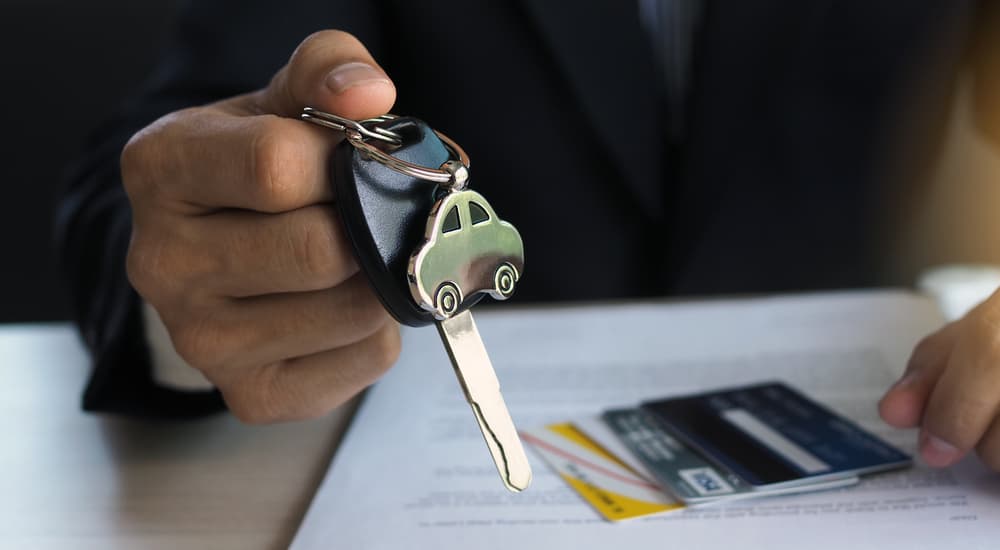“How do I value my car?” That’s the million-dollar question drivers are asking as used car prices soar. There’s no better time to sell your car because the value of used cars has never been higher. But why is this the case, and does this sky-high value come at a higher cost to you? These are questions that we should all ask as we navigate the changing tides of the automotive industry.
Economics 101: Supply and Demand
Our economy runs on the basic principle of supply and demand. A consumer has wants and needs that a business can meet with their services or products. For example, you need food to survive, so a grocery store or local farmer’s market provides that food—or a supply store carries the tools you need to start your garden. Likewise, you need reliable transportation, and automakers deliver their products via dealerships across the country to meet that need.
So, how does this impact the value of your vehicle? When demand exceeds supply, prices increase. In other words, when businesses start running low on products, but customers’ needs continue to grow, any inventory they have becomes even more valuable. It’s like finding water in the desert; demand exceeds supply.

Demand Exceeds Supply: The Current Automotive Landscape
Fortune magazine reported that used car prices rose 45% in January 2022, revealing a significant change in the American automotive landscape. The economy’s rising inflation has directly contributed to this, pushing prices higher than they have been in decades. Inflation is literally affecting everything from groceries and fuel to cars and beyond.
There are also several other key contributors to the rising price of used cars. Events over the last few years that forced businesses to shut down have dramatically affected the automotive industry. These businesses include production facilities and manufacturing plants responsible for building the semiconductors and microchips needed for modern vehicles. With no one working, automakers faced a huge setback. They didn’t have the necessary parts to complete their lineups.
The growing scarcity of microchips and other components left dealerships’ lots nearly empty. However, drivers need reliable transportation now and, in many cases, realistically can’t wait for automakers to recover. As a result, the supply of new cars might be low, but high demand remains, thus leading to the exponential growth of the used car market.
Redefining “Affordable”
With the notable absence of new models, the demand for used cars, trucks, and SUVs has consistently increased over the last several years. This demand has also prompted higher prices, making used cars more valuable than ever. However, it’s a catch-22. What does this mean?
The value of your car is higher today than ever, which is an excellent prospect if you’re interested in selling it and walking away with cash in hand. For example, a 2013 Chevy Equinox will fetch more money than ever—even with 107,000 miles on the odometer—because more people are looking for older models with more affordable price tags. So if you can walk away from your Equinox without having to buy another model, it’s the perfect seller’s market.
Unfortunately, this isn’t the situation most drivers find themselves in. Most of us have no other option but to trade in our vehicles, but how might this negatively impact our budgets and bottom lines? It comes down to how you define what’s affordable.
The heightened demand for used cars sent prices soaring, with many trucks and SUVs marked $10,000 over the traditional asking price. According to Consumer Reports, Subarus fall on the more affordable end of the spectrum but are still priced nearly $7,000 more than what consumers paid a few years ago. This demand might make your car more valuable, but you must also look beyond the trade to your next purchase.
“The silver lining for consumers is that even though prices are higher, your trade-in will never be worth more than it is today,” says Lauren Donaldson of PureCars, consulting agency. “That may put you in a better position to purchase a new car.” But, while this may be true, what’s the cost to you? Sure, you may get $10,000 more for your trade, but it’s also nearly impossible not to overspend in the current market.
So, how do you define what’s affordable? The average car on the road today is 12 years old, proving that Americans are driving and holding onto their vehicles longer than ever. As a result, there are very few budget-friendly options on the used lot—specifically those priced under $15,000. This forces many to redefine what’s affordable, since most used cars, trucks, and SUVs fall between $20,000 and $35,000 on the used lot—a price spectrum that could get you behind the wheel of a new model not long ago.
Using the System to Your Favor
Today, new and used cars are still in short supply, and prices remain relatively high; however, the industry will eventually level itself out as interest rates rise. Even so, dealerships are scrambling to find cars to add to their lots—meaning your car is still incredibly valuable, especially if it’s less than five years old. This puts you in a prime position to sell, giving you a clear advantage if you know how to negotiate a deal in your favor. So, what’s the best method?
The demand for cars, trucks, and SUVs puts you at a clear advantage. Drivers have unknowingly flipped the script in the automotive market (and not by choice). The vast supply that once sat on dealership lots is now gone, giving consumers more selling power. Your vehicle is a hot commodity among dealers, so now you’re supplying the dealer’s inventory needs.
With this in mind, remember that you’re in control of the process. The vast shortage of models gives you greater power and the opportunity to shop your vehicle around at multiple dealerships. By using online valuation tools like Kelley Blue Book, you can get a better idea of your vehicle’s value and determine which dealership makes the best offer.
Even if the dealership with the best offer doesn’t have the model you want to trade in for, you can walk away with the cash to spend elsewhere—or have the dealer do the legwork to add the model to its inventory to facilitate the trade. In the current climate, you may not have control over the sticker price of your next vehicle, but you do hold the reins of what you’ll accept for your current model. That power is incredible leverage.
Key Takeaways
Supply and demand lay the foundation of our economy, but sometimes the script gets flipped, and consumers aren’t reliant on businesses to meet their needs. Instead, it’s the other way around. This is the position automakers and dealerships around the country are in today as they desperately look to add inventory to their lots. Sure, they’re still looking to meet drivers’ demands, but they have less power.
The value of your car is higher today than it ever has been, and that puts you in a unique position. Dealerships are paying top-dollar for used models, making the car, truck, or SUV in your driveway a hot commodity. So, if you’re ready to trade or sell, use the situation to your advantage to get the most for your vehicle—at a time when everyone is looking for cars, trucks, and SUVs that won’t break the bank.




